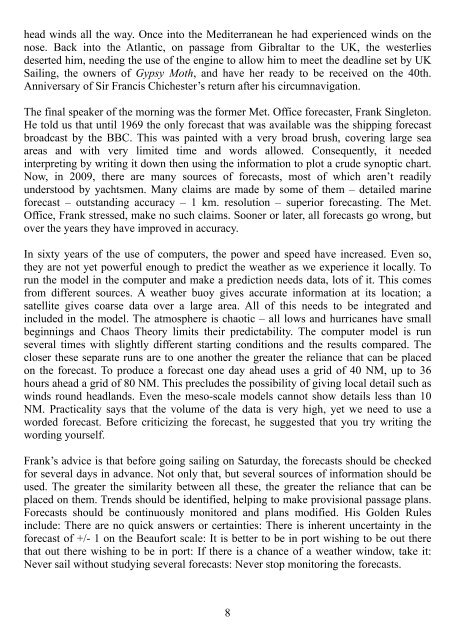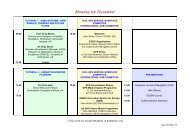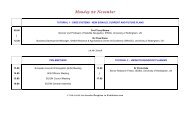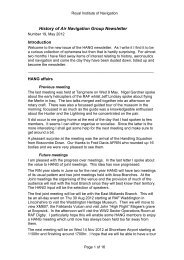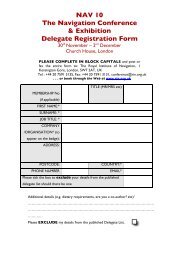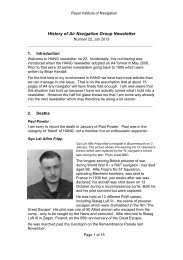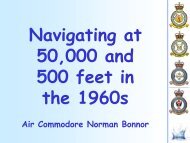Fairway 30 - Royal Institute of Navigation
Fairway 30 - Royal Institute of Navigation
Fairway 30 - Royal Institute of Navigation
You also want an ePaper? Increase the reach of your titles
YUMPU automatically turns print PDFs into web optimized ePapers that Google loves.
head winds all the way. Once into the Mediterranean he had experienced winds on the<br />
nose. Back into the Atlantic, on passage from Gibraltar to the UK, the westerlies<br />
deserted him, needing the use <strong>of</strong> the engine to allow him to meet the deadline set by UK<br />
Sailing, the owners <strong>of</strong> Gypsy Moth, and have her ready to be received on the 40th.<br />
Anniversary <strong>of</strong> Sir Francis Chichester’s return after his circumnavigation.<br />
The final speaker <strong>of</strong> the morning was the former Met. Office forecaster, Frank Singleton.<br />
He told us that until 1969 the only forecast that was available was the shipping forecast<br />
broadcast by the BBC. This was painted with a very broad brush, covering large sea<br />
areas and with very limited time and words allowed. Consequently, it needed<br />
interpreting by writing it down then using the information to plot a crude synoptic chart.<br />
Now, in 2009, there are many sources <strong>of</strong> forecasts, most <strong>of</strong> which aren’t readily<br />
understood by yachtsmen. Many claims are made by some <strong>of</strong> them – detailed marine<br />
forecast – outstanding accuracy – 1 km. resolution – superior forecasting. The Met.<br />
Office, Frank stressed, make no such claims. Sooner or later, all forecasts go wrong, but<br />
over the years they have improved in accuracy.<br />
In sixty years <strong>of</strong> the use <strong>of</strong> computers, the power and speed have increased. Even so,<br />
they are not yet powerful enough to predict the weather as we experience it locally. To<br />
run the model in the computer and make a prediction needs data, lots <strong>of</strong> it. This comes<br />
from different sources. A weather buoy gives accurate information at its location; a<br />
satellite gives coarse data over a large area. All <strong>of</strong> this needs to be integrated and<br />
included in the model. The atmosphere is chaotic – all lows and hurricanes have small<br />
beginnings and Chaos Theory limits their predictability. The computer model is run<br />
several times with slightly different starting conditions and the results compared. The<br />
closer these separate runs are to one another the greater the reliance that can be placed<br />
on the forecast. To produce a forecast one day ahead uses a grid <strong>of</strong> 40 NM, up to 36<br />
hours ahead a grid <strong>of</strong> 80 NM. This precludes the possibility <strong>of</strong> giving local detail such as<br />
winds round headlands. Even the meso-scale models cannot show details less than 10<br />
NM. Practicality says that the volume <strong>of</strong> the data is very high, yet we need to use a<br />
worded forecast. Before criticizing the forecast, he suggested that you try writing the<br />
wording yourself.<br />
Frank’s advice is that before going sailing on Saturday, the forecasts should be checked<br />
for several days in advance. Not only that, but several sources <strong>of</strong> information should be<br />
used. The greater the similarity between all these, the greater the reliance that can be<br />
placed on them. Trends should be identified, helping to make provisional passage plans.<br />
Forecasts should be continuously monitored and plans modified. His Golden Rules<br />
include: There are no quick answers or certainties: There is inherent uncertainty in the<br />
forecast <strong>of</strong> +/- 1 on the Beaufort scale: It is better to be in port wishing to be out there<br />
that out there wishing to be in port: If there is a chance <strong>of</strong> a weather window, take it:<br />
Never sail without studying several forecasts: Never stop monitoring the forecasts.<br />
8


